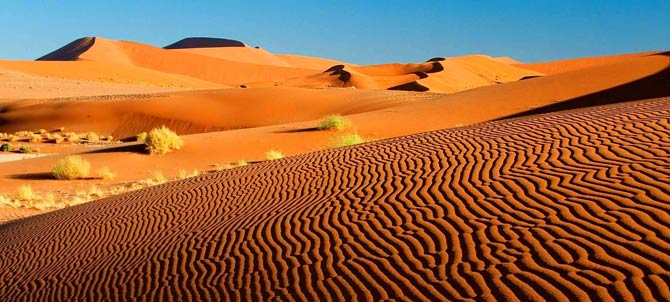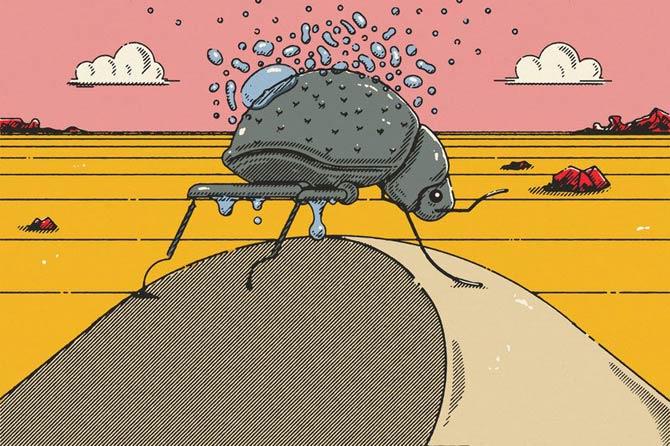Namibian beetles – dew and mist catchers
Can the darkling Namibian beetle help people?
Every morning you use the toilet, wash your hands and teeth, take a shower, make breakfast, do the dishes, and do the laundry. You use the water at least ten times before you leave for work.
Meanwhile, in southern Africa, in remote Namibia, before anyone can do these things, a woman or a child has to fetch life-giving water from a spring. Usually the source is not 5 minutes from home. The carriers walk a few hours back and forth every day so that their family can even drink.
Desert – a challenge
In desert areas, obtaining water is a real challenge. However, there is someone who can give the inspiration to solve this problem, someone who uses the specifics of the Namib desert to collect the life-giving fluid. We will meet the hero of our story in a moment…
Worldwide, around 900 million people have no direct access to drinking water.

The Namib Desert – dry and yet humid
The Namib Desert is said to be one of the driest deserts in the world. Yet travelers agree that it is teeming with life, even though only 2 mm of rain falls here annually. The liquid, essential for living organisms, comes from the mists that blow over the desert from the ocean every morning.
The humid air reaches up to 60 km into the desert and, settling on plants, feeds small animals. One of them has a unique ability to get water directly from the morning mist. And since it itself is 40% composed of this liquid, it is also a source of water for larger animals.

How to get water from dew and fog?
Portrait of a Namibian beetle – a dew and mist catcher
The darkling beetles (Namibian beetles) of the genus Stenocara are species that possess these remarkable abilities. Their black and white (Stenocara gracilipes) / black (Stenocara dentata) shells are covered with water-attracting (hydrophilic) nodules with waxy hydrophobic (liquid-repelling) tubules between them. Due to its color, the insect absorbs heat during the day, which is useful for the water uptake process. The genus Stenocara includes:
- Stenocara dentata
- Stenocara eburnea
- Stenocara gibbipennis
- Stenocara globulum
- Stenocara gracilipes
Every morning the beetle performs interesting acrobatics. Already at the end of the night, he begins to climb the dune to be as high as possible. When it reaches the desired point, it positions the body towards the breeze at a 45 ° angle, tilting its head downward and exposing its long, spindly back legs upwards. Its shell begins to give off heat, cooling the beetle down and making its body temperature cooler than that of its surroundings.

When fog approaches in the morning, its micro-droplets are attracted by hydrophilic nodules that hold them in place and flatten them. Thanks to this, the wind is not able to blow away the valuable liquid and its next particles can stick to them, creating larger drops.
Once the droplet is large enough, it begins to run down the slippery, hydrophobic gutters. In this way, due to gravity and the correct position of the body, the water moves towards the head, all the way to the mouth of the beetle, providing it with the drink it needs for the whole day.
Researchers have observed that these beetles are also able to obtain water from dew, i.e. from moist air that does not come from fog but settles, for example, on plants.
So the people of Namibia rightly call these creatures fog and dew catchers.
Scientists, thanks to the observation of beetles and learning about their structure, were able to create technologies that help to collect water in unfavorable desert conditions.

The human version of the fog catcher
The system inspired by the Namibian beetle is in the form of a vertically oriented net, similar to a tennis net. Its fibers, fiber coatings and openings are specially adapted to “catch” water from fog.
Work on the system and its improvement has been going on for a long time and is gradually spread all over the world and used in at least 17 countries.
Scientists initially used meshes with large openings, but then made them denser, improving efficiency by 8%. They also applied hydrophobic fiber coatings, thanks to which the drops of mist collected on them flow freely into the tanks. Besides, after much research, it was discovered that the chemical composition of the mesh fibers themselves is important. Stainless steel fibers of a certain thickness and spacing have proven to be optimal.
The human mist catchers constructed in this way are capable of collecting several liters of drinking water per day from every square meter of the net. This water is suitable for drinking as the desalination and purification of the mist droplets takes place in the air using natural processes. Therefore, obtaining drinking water does not involve any costs (apart from building a net), which makes it an excellent solution in dry and poor regions.
The mist (fog) catcher system is still being improved (for example, some people add specially constructed gutters to the meshes). There are even mesh design and building courses. The creators of this method donated the invention to UNESCO so that it could be copied free of charge and provide access to drinking water to all people in need across the globe.

A forest in the Sahara desert, i.e. a greenhouse for water
Scientists studying the Namibian beetle also came up with the idea of creating a greenhouse that collects drinking water from the air.
They built it based on evaporation grates connected into walls. These grids are flooded with a small amount of seawater. The wind blowing through the bars carries the salty droplets into the greenhouse where the plants are planted. As a result, the temperature inside drops, so plants can grow and the seawater condenses, losing its saltiness and becoming fit for consumption.
Simultaneously with the water-harvesting greenhouse, engineers use concentrated solar energy technologies to create two symbiotic systems.
This technology uses mirrors that focus light at a single point to produce electricity. This system needs the water extracted from the greenhouse and itself releases the heat needed for it to function properly. At the same time, the shadow cast by the mirrors provides optimal conditions for plant growth.

Self-filling bottle
A self-refilling bottle design is also in the research phase. Its prototype is equipped with hydrophilic and hydrophobic surfaces. Like the beetle, the moist air is supposed to settle on the walls of the bottle, so that water is collected inside.
If this technology can be implemented at a low cost and created an inexpensive product, it could prove very useful for individuals traveling through the dry sands of the desert.

Hydrophobic-hydrophilic material for windows and roofs
Researchers are also working on using a water-collecting material with a hydrophobic-hydrophilic structure, that is, it attracts and passes water on. Materials with such a textured surface could be used on the roofs of buildings, as well as a common rainwater drainage system, except that they would collect moisture from the fog and air and not from the rain.
The beetle drainage system with wax channels can also be used to create special coatings for windows and mirrors so that they do not fog up. Such a solution could also be useful in humid regions of the world.
- Hydrophobicity – the tendency of chemical molecules to repel water molecules from each other
- Hydrophilicity – the tendency of chemical molecules to associate with water.

Interesting facts
- National Parks were created in Namibia to protect the fauna and flora of this region from people who, desperate for the prolonged drought, began to significantly deplete the country’s natural resources, e.g. by killing wild animals.
- Protection was also needed because of diamond hunters who, since the beginning of the 20th century, have been destroying these areas and using the local population in pursuit of precious stones.

Recommended
- Ants – unusual insects
- The fly and its extraordinary abilities
- Amazing butterfly wings
- Locust anti-collision system
- Fastest animals – Top 100
- Fastest animals – on land, in water and in the air
- Fastest mammals
- Fastest birds
- Most venomous snakes – Top 10
- Largest eagles – Top 10
- Largest birds of prey
- Smartest dogs – Top 10
- Animals records
- Largest crocodiles
- Longest whales
- Heaviest whales
- Longest snakes
- Most venomous snakes
- Largest sharks
- Top-flying birds


















